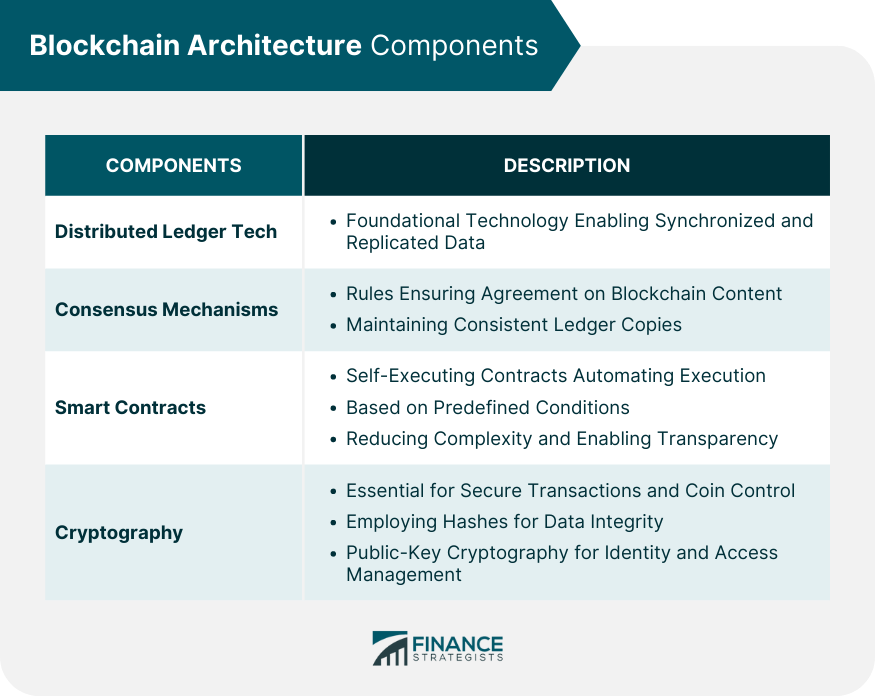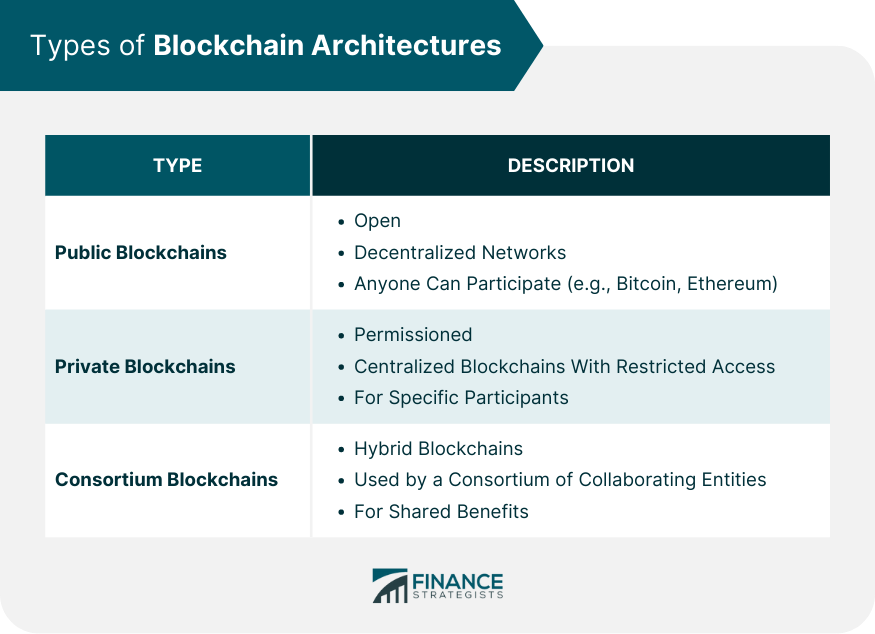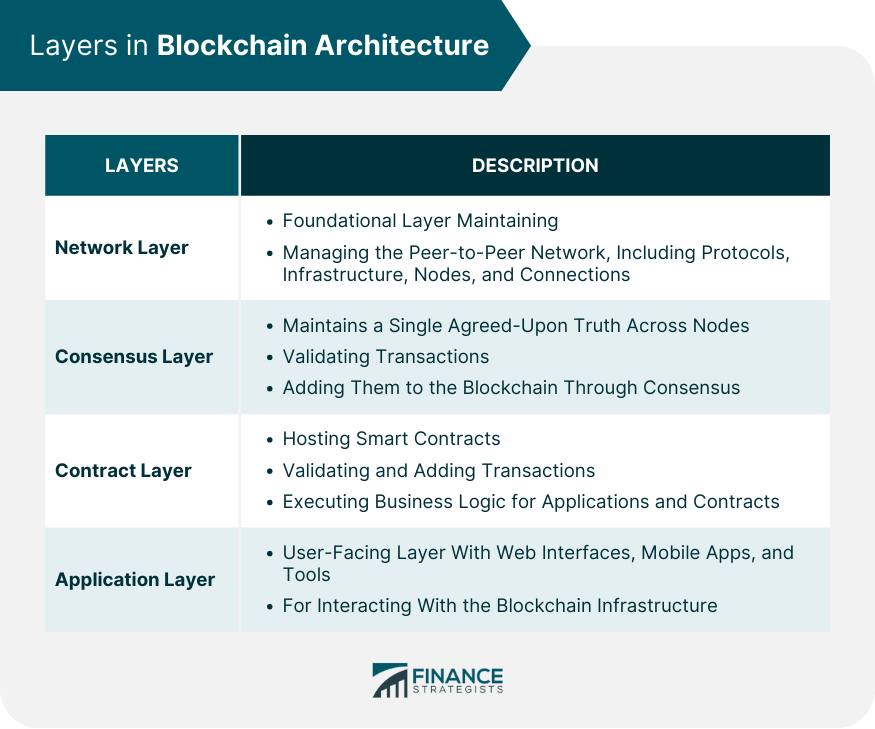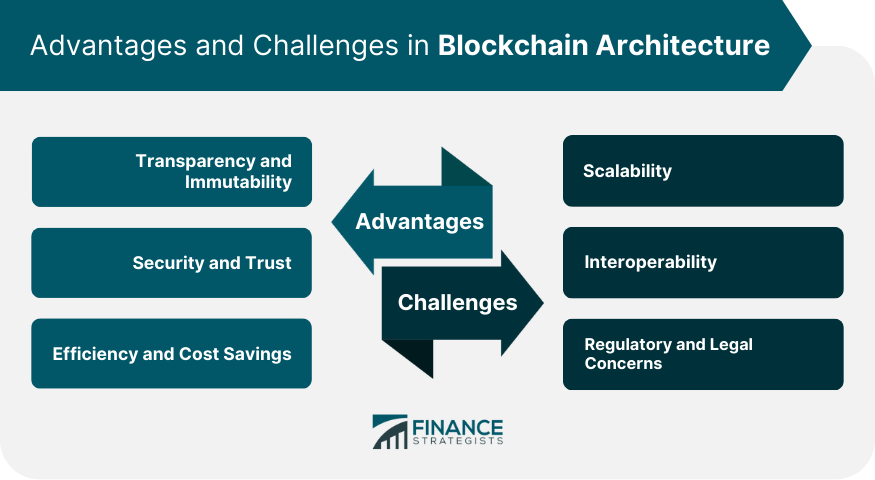Blockchain architecture refers to the underlying components and structures that constitute a blockchain network. It encompasses various components like nodes, chains, blocks, miners, and multiple layers that interact in a complex, decentralized ecosystem. At its core, blockchain architecture is based on a distributed database known as Distributed Ledger Technology. This system allows for data storage across multiple nodes, ensuring transparency, immutability, and enhanced security. The data is stored in interconnected blocks, with each block containing a hash of the preceding block, transaction data, and a timestamp, forming a chain of blocks. Distributed Ledger Technology, or DLT, is the foundational technology behind blockchain. It represents a consensus of replicated, shared and synchronized digital data spread across multiple sites or nodes, with no central data store or administrative functionality. The advent of DLT has marked a departure from traditional databases stored in a centralized location. It introduces an environment where all participants have access to the complete ledger of information and participate in the consensus process to validate new transactions. Consensus mechanisms play a crucial role in maintaining the integrity and security of blockchain networks. They are the rules set in place for agreeing on the contents of the blockchain and ensuring that all copies of the distributed ledger share the same state. Consensus mechanisms vary across different blockchain architectures. Some of the popular consensus mechanisms include Proof of Work (PoW), Proof of Stake (PoS), and Delegated Proof of Stake (DPoS). Each offers different advantages and trade-offs, with some emphasizing security and decentralization while others focus on speed and scalability. Smart contracts are self-executing contracts embedded with the terms of the agreement in code. They are triggered by certain conditions defined in the contract and, once activated, can facilitate, verify, or enforce the negotiation or execution of a contract. Smart contracts enable credible transactions without third parties, providing a way to exchange money, property, shares, or anything of value in a transparent, conflict-free environment. They have the potential to significantly reduce the complexities, costs, and inefficiencies of traditional contract law. Cryptography is an essential component of blockchain architecture, providing the means to secure transactions and control the creation of new coins. It is used to link the contents of the newly added block with each block before it, ensuring that all copies of the distributed ledger share the same state. Cryptographic hashes ensure data integrity and authenticity, while public-key cryptography provides a mechanism for secure identity and access control. Together, these cryptographic techniques provide a robust security foundation for blockchain technology. Public blockchains are completely open, and anyone can join and participate in the network. They are decentralized and distributed across a large network of computers, with no single entity owning or controlling the network. Bitcoin and Ethereum are well-known examples of public blockchains. These networks are secured by crypto economic systems that incentivize participants (also known as miners) to validate transactions. Private blockchains, also known as permissioned blockchains, have a more centralized architecture. They are only accessible to a selected group of participants who have been invited by the network administrators. Private blockchains offer the benefits of blockchain technology, such as immutability and transparency, but also allow for greater control over who can access the network and participate in the consensus process. Consortium blockchains, or federated blockchains, are a hybrid form, offering a compromise between the low trust requirement of public blockchains and the single highly-trusted entity model of private blockchains. They are typically used by a consortium of entities who collaborate to share benefits. In a consortium blockchain, the consensus process is controlled by a pre-selected group of nodes. For example, one might imagine a consortium of 15 financial institutions, each of which operates a node and of which 10 must sign every block for the block to be valid. The Network Layer is the foundational layer of blockchain architecture. It is responsible for maintaining and managing the peer-to-peer network. This layer includes the networking protocol and infrastructure necessary to maintain the distributed nature of the blockchain, such as network nodes and connections between them. The Consensus Layer is responsible for maintaining a single agreed-upon version of the truth across all nodes in the network. This encompasses the consensus algorithm used to agree on the validity of transactions and add them to the blockchain. The Contract Layer, also known as the application layer, is where all the applications and smart contracts reside. It interacts with the consensus layer to validate and add transactions to the blockchain. This layer is responsible for executing the business logic of applications and contracts. The Application Layer, which is often considered a part of the contract layer, includes the user-facing applications that interact with the blockchain. This might include web interfaces, mobile apps, and other tools that allow users to interact with the underlying blockchain infrastructure. Blockchain architecture offers unprecedented levels of transparency and immutability. Every transaction made on a blockchain is visible to all participants, which discourages fraudulent activities. Moreover, once a transaction is validated and added to the blockchain, it cannot be changed or tampered with, making the data highly trustworthy and reliable. Blockchain architecture is inherently secure because of its decentralized nature and the use of cryptographic techniques. Transactions are encrypted and linked to previous transactions, making it extremely difficult for hackers to alter the information. Moreover, the consensus mechanisms ensure that all participants agree on the validity of transactions, creating an environment of trust even in the absence of a central authority. By eliminating intermediaries and automating processes through smart contracts, blockchain can speed up transactions, reduce errors, decrease operational costs, and revolutionize industries. One of the major challenges of blockchain architecture is scalability. As the size of the blockchain grows, the requirements for storage, bandwidth, and computational power that is required by fully participating in the network increase rapidly. The challenge lies in making blockchain scalable while maintaining its decentralization and security features. With multiple blockchain networks in existence, each with its own protocols and standards, it is currently difficult for these networks to interact with each other. Efforts are being made to create interoperability standards and frameworks, but achieving true interoperability across all blockchain networks is still a considerable challenge. Regulatory and legal issues represent another challenge for blockchain architecture. The decentralized, borderless nature of blockchain makes it difficult for any single jurisdiction to regulate its use. Moreover, many legal aspects of blockchain, such as smart contract enforcement and data privacy, are still largely unexplored, making it a risky technology for mainstream adoption. Blockchain architecture refers to the underlying components and structure of a blockchain network. It offers unprecedented advantages such as transparency, immutability, security, and efficiency. Its decentralized nature and cryptographic techniques ensure trust and integrity in transactions, making it a disruptive technology with the potential to revolutionize various industries. By eliminating intermediaries and employing smart contracts, blockchain enhances efficiency, reduces errors, and lowers operational costs. Challenges remain in terms of scalability as the demands on storage and computational power increase with the growth of the blockchain. Interoperability among different blockchain networks is another hurdle that needs to be addressed to enable seamless communication and collaboration. Additionally, regulatory and legal concerns pose uncertainties and hinder widespread adoption. Despite these challenges, the transformative potential of blockchain architecture cannot be overlooked. As efforts continue to address the limitations and establish industry standards, blockchain holds the promise of a future where secure, decentralized, and efficient transactions become the norm across diverse sectors.What Is Blockchain Architecture?
Components of Blockchain Architecture
Distributed Ledger Technology (DLT)
Consensus Mechanisms
Smart Contracts
Cryptography

Types of Blockchain Architectures
Public Blockchains
Private Blockchains
Consortium Blockchains

Layers of Blockchain Architecture
Network Layer
Consensus Layer
Contract Layer
Application Layer

Advantages of Blockchain Architecture
Transparency and Immutability
Security and Trust
Efficiency and Cost Savings
Challenges of Blockchain Architecture
Scalability
Interoperability
Regulatory and Legal Concerns

Conclusion
Blockchain Architecture FAQs
Blockchain architecture refers to the underlying structure and components that constitute a blockchain network. It includes a distributed ledger, consensus mechanisms, smart contracts, and cryptographic techniques.
Key components of blockchain architecture include distributed ledger technology (DLT), consensus mechanisms, smart contracts, and cryptography.
Blockchain architectures can be categorized into public, private, and consortium blockchains, each with unique characteristics and use cases.
Blockchain architecture offers several advantages, including transparency and immutability, security and trust, and efficiency and cost savings.
Challenges faced by blockchain architecture include scalability issues, lack of interoperability between different blockchain networks, and regulatory and legal concerns.
True Tamplin is a published author, public speaker, CEO of UpDigital, and founder of Finance Strategists.
True is a Certified Educator in Personal Finance (CEPF®), author of The Handy Financial Ratios Guide, a member of the Society for Advancing Business Editing and Writing, contributes to his financial education site, Finance Strategists, and has spoken to various financial communities such as the CFA Institute, as well as university students like his Alma mater, Biola University, where he received a bachelor of science in business and data analytics.
To learn more about True, visit his personal website or view his author profiles on Amazon, Nasdaq and Forbes.















